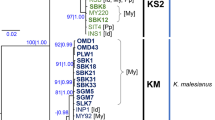Abstract
Kappaphycus alvarezii which is endemic to the Indo-Pacific region is the main raw material for kappa carrageenan production. A seedling that was cultivated in Japan (originally from the Philippines) was introduced in a trial, for aquaculture purpose, in 1995, in São Paulo State, southeastern region of Brazil. It was later introduced in Santa Catarina State, in Southern Brazil. In 1998, another seedling that was brought from Venezuela, also originally from the Philippines, was commercially introduced at Ilha Grande Bay and later on at Sepetiba Bay, both in Rio de Janeiro State. The aim of this study was to characterize 21 samples from different farms (Rio de Janeiro and Santa Catarina States) and verify if they are K. alvarezii or other species. Based on the intergenic spacer cox2-3 sequences, phylogenetic relationships were inferred through neighbor joining, maximum likelihood, and Bayesian analyses. The topology of the trees suggests that all samples from the different farms form a monophyletic group of K. alvarezii. Statistical analysis of the cox2-3 marker calculated with median-joining network showed 38 variable positions defining 15 haplotypes for the studied samples of Kappaphycus. The most frequent K. alvarezii haplotype grouped the samples cultivated worldwide with the Brazilian samples. These results are important for better productivity and are environmentally desirable for introduction purposes since the species introduced is known and will help focusing the research on this species. This knowledge can be of assistance to the government in setting up environmental and cultivation protocols to achieve sustainability in macroalgae aquaculture.


Similar content being viewed by others
References
Ask EI, Azanza RV (2002) Advances in cultivation technology of commercial eucheumatoid species: a review with suggestions for future research. Aquaculture 206:257–277
Bandelt H-J, Forster P, Rohl A (1999) Median-joining networks for inferring intraspecific phylogenies. Mol Bio Evol 16:37–48
Bixler HJ, Porse H (2011) A decade of change in the seaweed hydrocolloids industry. J Appl Phycol 23:321–335
Bulboa CR, Paula EJ, Chow F (2007) Laboratory germination and sea out-planting of tetraspore progeny from Kappaphycus (Rhodophyta) in subtropical waters of Brazil. J. Appl. Phycol 19: 357–363.
Castelar B, Reis RP, Moura A, Kirk R (2009) Invasive potential of off the south coast of Rio de Janeiro state, Brazil: a contribution to environmentally secure cultivation in the tropics. Bot Mar 52:283–289
Conklin KY, Kurihara A, Sherwood AR (2009) A molecular method for identification of the morphologically plastic invasive algal genera Eucheuma and Kappaphycus (Rhodophyta, Gigartinales) in Hawaii. J Appl Phycol 21:691–699
Desenvolvimento—Ministério do Desenvolvimento, Indústria e Comércio Exterior (2010) Alice web (online query) (http://aliceweb.desenvolvimento.gov.br/). Accessed Feb 2010
Doyle JJ, Doyle DJL (1987) A rapid DNA isolation procedure for small quantities of fresh leaf tissue. Phytoc Bull 19:11–15
Felsenstein J (1985) Confidence limits on phylogenies: an approach using the bootstrap. Evolution 39:738–791
Góes HG, Reis RP (2011) An initial comparison of tubular netting versus tie–tie methods of cultivation for Kappaphycus alvarezii (Rhodophyta, Solieriaceae) on the south coast of Rio de Janeiro State, Brazil. J Appl Phycol 23:607–613
Guindon S, Gascuel O (2003) A simple, fast, and accurate algorithm to estimate large phylogenies by maximum likelihood. Syst Biol 52:696–704
Hayashi L, Santos AA, Faria GSM, Nunes BG, Souza MS, Fonseca ALD, Barreto PLM, Oliveira EC, Bouzon ZL (2011) Kappaphycus alvarezii (Rhodophyta, Areschougiaceae) cultivated in subtropical waters in Southern Brazil. J Appl Phycol 23:337–343
Huelsenbeck JP, Ronquist F (2001) MRBAYES: Bayesian inference of phylogenetic trees. Bioinformatics 17:754–755
Maddison DR, Maddison WP (2001) MacClade 4.06: analysis of phylogeny and character evolution. Version 4.0. Sinauer Associates, Sunderland
Paula EJ, Pereira RTL, Ohno M (1999) Strain selection in Kappaphycus alvarezii var. alvarezii (Solieriaceae, Rhodophyta) using tetraspore progeny. J Appl Phycol 11:111–121
Pickering TD, Skelton P, Sulu JR (2007) Intentional introductions of commercially harvested alien seaweeds. Bot Mar 50:338–350
Posada D (2008) JModelTest: phylogenetic model averaging. Mol Biol Evol 25:1253–1256
Ronquist F, Huelsenbeck JP (2003) MRBAYES 3: Bayesian phylogenetic inference under mixed models. Bioinformatics 19:1572–1574
Smith AH, Rincones RE (2006) The seaweed resources of the Caribbean. In: Critchley AT, Ohno M, Largo DB (eds) World seaweed resources—an authoritative reference system. ISBN 90 75000 804. ETI, UK, DVD-ROM
Zemke-White WL, Smith JE (2006) Environmental impacts of seaweed farming in the tropics. In: Critchley AT, Ohno M, Largo DB (eds) World seaweed resources—an authoritative reference system. ISBN 90 75000 804. ETI, UK, DVD-ROM
Zhao S, He P (2011) Molecular identification based on ITS sequences for Kappaphycus and Eucheuma cultivated in China. Chin J Oceanol Limnol 29:1287–1296
Zuccarello GC, Burger G, West JA, King RJ (1999) A mitochondrial marker for red algal intraspecific relationships. Mol Ecol 8:1443–1447
Zuccarello GC, Critchley AT, Smith J, Sieber V, Lhonneur GB, West JA (2006) Systematics and genetic variation in commercial Kappaphycus and Eucheuma (Solieriaceae, Rhodophyta). J Appl Phycol 18:643–651
Acknowledgments
The authors would like to thank FAPERJ and CNPq for granting financial support, to Dr. Leila Hayashi for providing K. alvarezii specimens from experimental farms located at Santa Catarina State, to Ondas Biomar Cultivo de Algas Ltda and MD Algam for specimens cultivated in Rio de Janeiro State, and to Rafael Rodrigues Loureiro for his comments in the manuscript.
Author information
Authors and Affiliations
Corresponding author
Rights and permissions
About this article
Cite this article
de Barros-Barreto, M.B.B., Marinho, L.C., Reis, R.P. et al. Kappaphycus alvarezii (Gigartinales, Rhodophyta) cultivated in Brazil: is it only one species?. J Appl Phycol 25, 1143–1149 (2013). https://doi.org/10.1007/s10811-012-9952-8
Received:
Revised:
Accepted:
Published:
Issue Date:
DOI: https://doi.org/10.1007/s10811-012-9952-8




